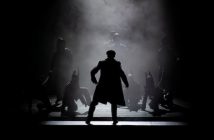It’s agonizing to watch a dancer bid farewell – defined as it is by its physicality, the job seems to take with it part of the life breath from the performer when it departs them. It was thus that Darcey Bussell’s lithe frame seemed to crumple when she retired from the Royal Ballet nearly a decade ago, requiring Monica Mason to hold her up as she took her applause,and so too with Carlos Acosta as he said his final goodbye from the classical stage at the Royal Albert Hall this week, surrounded by his friends and colleagues. As strong, as athletic, as dazzling as we know the Cuban to be, seeing his head bow, his back buckle and tears fall from his cheeks as the audience roared its appreciation of his parting shot made us all want to cry too.
Because Carlos Acosta is not just any old dancer – not merely a man in tights. Carlos Acosta is a shining light of the ballet world;he is the reason countless male dancers have had the guts to get to where they are today; he is the rock star, the heartthrob and the golden boy all at once, and has been for more than 20 years. And it so easily may not have been the case, but it is Acosta’s rise from the streets of Havana to the world’s most dazzling stages– despite being the youngest of 11 children born to a truck driver – that makes him the inspiration he is.

So if he wants to milk his exit, just a tad, then who are we to spoil his fun? You would be forgiven for getting a little confused at how many times he’s going to sign off, what with his final full-length performances, his final Royal Opera House performances with Don Quixote, and so forth. But this is decidedly the last time we will see him performing any sort of classical ballet, and then he’s back off to Cuba to work on projects there.
In Carlos Acosta: The Classical Farewell, the man himself has drawn together his friends in the industry for a gala-style programme of popular excerpts. And it is very much a dancer’s collection: a preciously curated set of things that those up on stage simply bask in performing. Hence the choreography of Macmillan and Balanchine abound, and you have big, ballsy slots from the vibrant Don Quixote, Jewels, Manon and Scheherazade – this is all fodder the dancers famously relish. And the consequence is joyful, even if some of the effect is lost by wrenching such segments from their broader context and reducing the staging; Acosta has the support of a full orchestra, a fabulous pianist, a choir and choral soloists, but the plain black stage is not always the most evocative. That said, Sarah Lamb’s delicate Dying Swan needs nothing more and is exquisitely framed amid the plain backdrop. Additionally, when Acosta pairs with Marianela Nuñez for the opening pas de deux of Kenneth Macmillan’s Winter Dreams, their sheer chemistry and conjoint charisma is enough to tell this melancholic love story.

Indeed, as soon as Nuñez’s gaze meets Acosta’s, their well-known spark on stage is very clearly ignited and one feels excited to be witnessing it one last time, whilst deeply saddened to know that this is the last chance to do so. They then move onto the much glitzier pas de deux from the finale of Don Quixote, which is all pomp and jollity. It is sadly undeniable that Acosta is no longer in his prime – the leaps simply aren’t as high, the strength (though unfailingly impressive) isn’t quite what it once was, but for anyone watching it just doesn’t matter: it’s Carlos Acosta for goodness’ sake! He is captivating and charming and enigmatic, and feeling his presence as he walks on to the stage, you equally cannot deny what a force he is. And he can still contend with the best male dancers in the business anyhow – don’t you worry. That is clear in the powerful and yet considerate way he partners the ethereal Yuhui Choe in a stunning performance of Macmillan’s Requiem. Choe, more and more, exhibits how technical precision can be so glisteningly teamed with fragile poeticism.
Ryoichi Hirano and Valentino Zucchetti make enthralling appearances throughout the show, but there are slightly disappointing ones from Gabriela Lugo and Sarah Lamb (bar her swan), who fail to project much personality in the vast auditorium. Come what may, it is Acosta’s final solo, Memoriathat sticks in the memory. Created for him in 2011 by fellow Cuban Miguel Altunaga to an electronica score, this shows his flair for both contemporary and street styles and is performed in one large, fixed spotlight. Acosta finally packs up his kit bag on a chair just off centre, and thoughtfully wanders off with the audience – both men and women – shouting out their thanks and distress at his exit. This is a landmark moment and Carlos Acosta’s adieu is one, big, unashamed love-in between all of the dancers, the audience, and everybody involved. Acosta is right that it is his time to go, but have no doubt that we’ll be following his future projects intently – a generation doesn’t let go of one of the greats that easily.
Carlos Acosta: The Classical Farewell took place at the Royal Albert Hall on 3rd October 2016.




